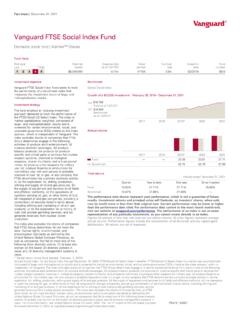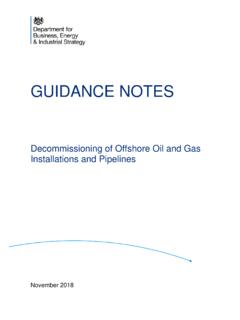Transcription of General Safety Orientation Guideline For the Oil & Gas ...
1 General Safety Orientation Guideline For the Oil & Gas Industry RELEASE DATE January 1, 2012 Table of Contents Scope .. 2 Purpose of this document .. 2 WorkSafe Saskatchewan Orientation Program Example .. 5 General Safety Orientation Evaluation Process .. 6 General Safety Orientation Program Evaluation: .. 7 Appendix 1: Example Employee Record of Orientation .. 12 Appendix 2: 10 Questions Young and New Workers in Alberta should ask their employer .. 15 Appendix 3: British Columbia OHS Guideline on Young or New Worker Orientation and Training.
2 17 Appendix 4: Industry General Safety Orientation Program Gap Analysis .. 22 Appendix 5: Proof of Orientation .. 27 References .. 28 Scope 2 SCOPE This document is not designed to interpret Canadian Provincial Occupational Health and Safety laws. It is not intended to be used in court. The information in this document is intended for General use and may not apply to every circumstance. It is not a definitive guide to government regulations and does not exempt any employer from their responsibilities under applicable legislation.
3 Where a conflict exists between this document and any applicable governmental Act, Regulation, or Code, the legislation shall have precedence. Industries under federal jurisdiction - such as inter-provincial pipelines, inter-provincial transportation, broadcasting and telecommunications, are governed by The Canada Labour Code. If you work in a federally regulated industry, please contact the appropriate agency for information or visit the Human Resources and Skills Development Canada web site at: This document does not contain Company specific, Prime Contractor Specific or Site Specific information.
4 Purpose of this document: The purpose of this document is to outline the minimum occupational health and Safety information that all employers are required to provide their new, young, and inexperienced workers upon hire or transfer. However, all employers are recommended to provide an on-boarding Orientation that will address company human resources, payroll, benefits, job description, HSE information, management system, programs, policies, standards, practices, procedures, roles and company responsibilities regardless of the jurisdiction in which they operate.
5 As well, all employers regardless of jurisdiction are required to conduct and participate in site specific orientations to cover the specific hazards, conditions, equipment, procedures, rules and regulations where the work occurs. This includes but is not limited to oil and gas well sites, plant sites, pipeline construction sites, seismic and other exploration operations, in situ operations, concurrent operations, and other active oil and gas work sites. Orientation is the process of introducing new, young, inexperienced, and transferred workers to the organization, their supervisors, co-workers, work areas, and jobs.
6 When working in British Columbia: The British Columbia Occupational Health and Safety Regulation section requires employers to provide young and new workers with a Safety Orientation . In BC any worker under the age or 25 is considered young. Section outlines the specific information that an occupational health and Safety Orientation must address. When working in Saskatchewan: The Saskatchewan Occupational Health and Safety Act, 1993, and The Occupational Health and Safety Regulations, 1996 require the employer to provide all new, inexperienced, and transferred workers with a basic health and Safety Orientation .
7 Orientation requirements are set out under section 19 of the regulations (Training of Workers). Orientation must include training a worker on all matters that are necessary to ensure the health and Safety of the worker at work, and must also include providing the worker with information on the specific matters set out in sub-section 19(2) of the Saskatchewan regulations. Scope 3 When working in Alberta: the Alberta Occupational Health and Safety Act, Section 2(1), and OHS Regulation Sections 12, 13, 15 require all employers to do everything reasonably practicable to ensure the health and Safety of workers under their employment or direction.
8 They must conduct a written hazard assessment and implement controls and ensure that workers are aware of their responsibilities and duties under the OHS Act. Employers must ensure that all equipment used at a work site is properly maintained and safe for use and that workers completing work are either competent to do so, or under the direct supervision of a worker who is competent. Every employer must ensure that workers are adequately trained in the safe operation of equipment, including Safety protective equipment and that they are adequately trained in the use of safe operating procedures, including any procedures designed to minimize the workers exposure to a harmful substance.
9 The initial period of employment is critical. During this phase, each worker develops the knowledge, skills, attitudes, and abilities that are necessary to work successfully. Unfortunately, workers are killed or injured every year because they aren t properly informed about workplace hazards or properly trained to do their jobs safely. Planning and organizing an effective Orientation is vital to prevention, particularly when a worker starts a new job or returns after an extended absence. Pay particular attention to workers who are: transferred to jobs or work areas they are unfamiliar with returning from an extended period away from work new to the work force The role of the Supervisor: The OHS legislation in BC, Alberta and Saskatchewan all contain a specific section on oil and gas .
10 In those sections the supervisor is specifically identified as responsible to ensure a healthy and safe work place. The supervisor can also be held criminally liable in the event of a serious incident under Section 217 of the Criminal Code of Canada which states: Every one who undertakes, or has the authority, to direct how another person does work or performs a task is under a legal duty to take reasonable steps to prevent bodily harm to that person, or any other person, arising from that work or task.






